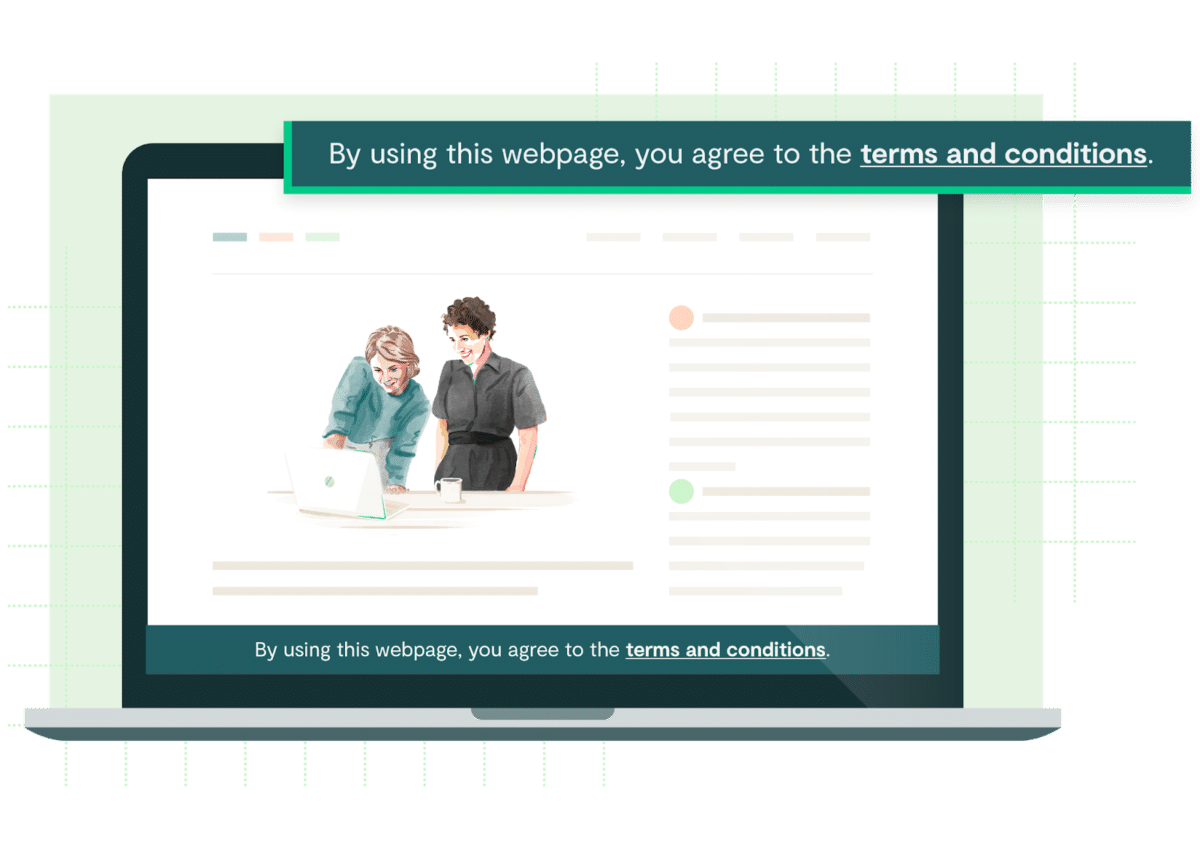Browsewrap agreements (also referred to as “browserwrap” or browse wrap license) are online contract or license agreements commonly used by websites, which state that by using the website the user assents to the site’s Terms and conditions, often presented via a hyperlink. However, while many companies use browsewrap agreements to present their online legal agreements, browsewrap agreements are often unenforceable.
In browsewrap agreements, both the notice and hyperlink to the terms are most often located at the bottom of the screen. Unlike a clickwrap agreement, where the user must manifest assent to the terms and conditions by checking a box, a browsewrap agreement does not require this type of manifestation of assent. Instead, users are considered to have accepted the website’s terms simply by using the website. To the court, the position of the notice and lack of affirmative assent from the user make these browsewraps unenforceable.
Browsewraps have a low enforceability rate
In Ironclad’s study on clickwrap litigation trends, a significant number of cases challenge the validity of browsewrap agreements. The study found that in 2020, browsewrap agreements only had 14% success rate, the lowest of the three types of online agreements. This is often because no affirmative action is required for the user to assent to the browsewrap’s terms.
The courts find the notion that users assent to the browsewrap terms simply by using the website is problematic because users often use websites without ever knowing that there is a browsewrap agreement attached. In Specht v. Netscape Communications, for example, the court declined to hold Netscape’s browsewrap enforceable because the hyperlink’s placement at the bottom of the screen failed to put users on notice of Netscape’s terms.
Similarly, in Hines v. Overstock.com, the court found Overstock.com’s browsewrap unenforceable because the website failed to prominently display the link to the online agreement in a way that would put users on notice of the website’s terms and conditions.
When would browsewrap agreements be enforceable?
When a user has actual notice of the agreement, courts tend to uphold browsewrap agreements. But actual notice can be difficult to obtain and hard to prove. Actual notice often requires more than just the simple implementation of a browsewrap agreement. Namely, either the user must concede that they had knowledge, or the website must show that it directly provided the user with notice of online terms, such as through a cease and desist letter.
Browsewrap case law example 1: Register.com v. Verio
In the case of Register.com v. Verio, the court found Register.com’s browsewrap valid because Verio conceded that it had actual knowledge of Register.com’s online agreement terms.
Browsewrap case law example 2: Southwest Airlines v. BoardFirst
Additionally, the court in Southwest Airlines v. BoardFirst found that BoardFirst had knowledge of Southwest’s terms because Southwest sent BoardFirst a cease and desist letter. Therefore, the browsewrap agreement alone, without the letter that put the defendant on notice, would likely not have been enough to win this case.
The importance of inquiry notice to browsewrap enforceability
If the user lacks actual notice of the terms, the validity of the agreement then depends on whether the user had inquiry notice of the contract’s existence. Inquiry notice (also known as implied notice) is heads up given to a user about the existence of something that would cause them to investigate further (i.e. read the Terms of Service).
However, whether a user is on inquiry notice varies widely in its interpretation. Inquiry notice is often determined by reviewing the design and layout of the webpage as it appeared during the time in question, though courts are split on whether or not a good design and layout is enough to establish inquiry notice.
Browsewrap case law example 3: PDC Laboratories v. Hach Co.
In PDC Laboratories v. Hach Co., the court found the browsewrap enforceable because the hyperlink was conspicuously displayed in contrasting text, and the checkout screen contained language telling the user to review the terms prior to completing the purchase.
Browsewrap case law example 4: Nguyen v. Barnes & Noble.
On the other hand, the court in Nguyen v. Barnes & Noble held that Barnes & Noble’s browsewrap was unenforceable despite the fact that the hyperlink was prominently placed next to the buttons users must click in order to complete online purchases.
All in all, today’s courts are highly unlikely to find browsewrap agreements enforceable unless the parties can establish actual or inquiry notice. But establishing such notice often requires more than just a simple implementation of the browsewrap agreement. Instead, the website owner must show that it did something additional to provide the user with notice of the online agreement and collected their affirmative assent. As a result, the likelihood of a court enforcing a browsewrap is tenuous at best.
Next steps for enforceable agreements
Not to worry though, there are newer, better forms of collecting user assent to your online agreements that your business can implement such as sign-in-wrap, clickwrap, or scroll wrap agreements.
Ironclad is not a law firm, and this post does not constitute or contain legal advice. To evaluate the accuracy, sufficiency, or reliability of the ideas and guidance reflected here, or the applicability of these materials to your business, you should consult with a licensed attorney. Use of and access to any of the resources contained within Ironclad’s site do not create an attorney-client relationship between the user and Ironclad.
- Browsewraps have a low enforceability rate
- When would browsewrap agreements be enforceable?
- The importance of inquiry notice to browsewrap enforceability
- Next steps for enforceable agreements
Want more content like this? Sign up for our monthly newsletter.




